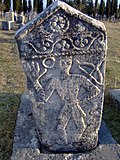Church of St. George, Sopotnica
| Church of St. George | |
|---|---|
| Church of Saint George | |
Crkva Svetog Đorđa | |
Gothic style elements | |
| Years built | around 1454 |
| Official name | Church of Saint George in Sopotnica, the architectural ensemble |
| Type | Category I cultural property |
| Criteria | A, B, C iii.iv.v., D iv., E i.iii.iv.v, G i.iii.v.vi. |
| Designated | 5 November 2008 (decision No. 07.1-02-81/03-10) |
| Reference no. | 3057 |
| List of National Monuments of Bosnia and Herzegovina | |
The Church of Saint George, Sopotnica (
History and architecture
The church is located four kilometres to the north of
1st phase - main building construction
The church was built in several phases. The first and oldest part was built in the mid 15th century as a small single-nave cruciform church of the Drina Type. The main measurements of the inside of the building, excluding the apse and choirs, are 8.50 by 4.50 m, while the height of the church is 7 metres at its pointed vault.[2]
A small single-nave cruciform main structure includes a semicircular
2nd phase - Catholic chapel added
The second phase included adding a
Immediately after the main building was finished, a 3 by 1.80 m rectangular paraklis (kind of a chapel) was built onto the north side of the altar parvis in the extension and next to the north choir, from which this new space is entered. Like the north choir, this chapel also has a barrel vault, with the same level apex at the 2.90 m. The paraklis was lit through A small window in shape of an inverse loophole to the east existed but was sometime later walled up. Its purpose was to bring daily light to this chapel.[6][5]
Enlargement and restoration works
In the second half of the 16th century, during the office of
Other uses
In 1519, at the beginning of the Ottoman rule over Herzegovina, one of the earliest
See also
Notes
References
- Kajmaković, Zdravko (1971). Zidno slikarstvo u Bosni i Hercegovini [Fresco-painting in Bosnia and Herzegovina] (in Serbian). Veselin Masleša. OCLC 5002857. Retrieved 1 November 2023.
- Џелетовић, Данило Н. (2007). Историја и страдање Херцегове цркве [History and Tribulations of the Herceg’s church]. Завод за уџбенике и наставна средства. ISBN 978-99955-0-176-1. Retrieved 1 November 2023.
- Barać, Dragan (2008). "Горажданска штампарија—прва међу штампаријама у Херцеговини и српским земљама 16. века". In Dragan Barać (ed.). Горажданска штампарија 1519–1523 [The Goražde Printing House 1519–1523] (in Serbian). Belgrade: ISBN 978-86-7035-186-8. Archived from the originalon 2014-04-08.
- Benac, Alojz; Lovrenović, Ivan (1980). Bosnia and Herzegovina. Sarajevo: Svjetlost.
- Fine, John Van Antwerp (1994). The Late Medieval Balkans: A Critical Survey from the Late Twelfth Century to the Ottoman Conquest. Ann Arbor, Michigan: ISBN 0-472-08260-4.
- Fotić, Aleksandar (2005). "Belgrade: A Muslim and Non-Muslim Cultural Centre (Sixteenth–Seventeenth Centuries)". In Antonis Anastasopoulos (ed.). Provincial elites in the Ottoman Empire. Halcyon Days in Crete. Vol. 5. Rethymno: Crete University Press. ISBN 9789605242169.
- Lovrenović, Dubravko (2008). Church of Saint George in Sopotnica. Bosnia and Herzegovina Commission to Preserve National Monuments. Archived from the original on 2014-04-08. Retrieved 2014-04-07.
- Ševo, Ljiljana (2004). Manastir Liplje (in Serbian). Lepavina Monastery.





